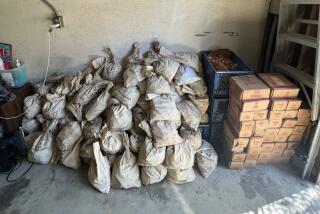In Mint Condition : Osborne Coinage Has Been Making a Strong Impression Since 1835
- Share via
CINCINNATI — Had Abraham Lincoln decided to shave his beard to run for president, Osborne Coinage Co. was ready.
When food rationing tokens were needed during World War II, Osborne Coinage came through.
Today, when the Chuck E Cheese’s pizza chain needs tokens for its restaurant games, it calls Osborne.
Osborne Coinage, established in 1835 as the Z. Bisbee Co., is the oldest private mint in the country, making everything from subway tokens to commemorative sports coins on this city’s industrial west side.
“We’ve got a long, rich history,” vice president Jeffrey Stegman said.
Indeed.
In the last century, politicians often relied on the company to produce the inexpensive coins they gave away on the campaign trail. Lincoln needed Osborne’s help as he wrestled with the beard-or-no-beard question in 1864, during his second presidential campaign.
“He couldn’t decide how he was going to run--with or without the beard--so he had us make two sets [of coin dies] showing him each way,” Stegman said.
“He ran with the beard, which was good--he was really ugly without it.”
Both sets of dies still sit in the company vault.
Osborne also made campaign coins for eight other presidential candidates, including Ulysses S. Grant and Franklin D. Roosevelt.
During World War II, the Office of Price Administration commissioned Osborne to make tokens to replace the small change handed out when food rationing coupons were redeemed.
Using 1,300 workers around the clock, Osborne made 5 billion of the red and blue tokens in five months, as many as 80 million a day.
“We had train tracks running up to the building--they were loading up cars every day,” said Stegman, whose family bought the mint two years after the war.
There are 40 to 50 private mints in the United States, said Paul Gilkes, a senior writer for Coin World magazine.
The first mint in what now is the United States was established in 1652 in Boston, prompted by a shortage of British coins and an influx of Dutch and Spanish coins. Many private mints opened during the Civil War.
“There was the need for small change--all the copper was being used for the war,” Gilkes said. “You had lots of different companies start up producing tokens for companies and merchants that were used as change.”
Today it’s a smaller field of private mints competing for business. Green Duck Corp., based in Hernando, Miss., is Osborne’s primary competitor, particularly in producing tokens for the booming casino gambling industry.
Osborne’s products include:
* Mass transit tokens. Philadelphia’s SEPTA mass transit system has bought 14 million train, trolley and bus tokens from Osborne since 1990. The company has made more than 100 million transit tokens for New York City.
* “Sobriety coins” given to members of Alcoholics Anonymous to mark the anniversary of the day they stopped drinking.
* Casino and amusement park tokens.
* Commemorative sports coins, such as one marking the opening of Denver’s Coors Field in 1995 and another commemorating the Chicago Bulls’ NBA championships.
* Millions of doubloons used each year at Mardi Gras in New Orleans.
* Promotional coins, such as the 17 million 1996 Olympic Games coins General Mills distributed in cereal boxes.
Gilkes calls Osborne “a top-flight company. A company wouldn’t stay in business that long if they turned out garbage.”
The coins are often made from aluminum, but Osborne also works in gold, silver, brass, nickel and other metals.
Each coin starts with a conceptual drawing that can be enhanced using a computer. The design then is etched into two dies, one for each side of the coin.
Massive rolls of metal alloys are shaped into blank coins and loaded into presses that stamp the image from the dies onto each coin using 200 tons of pressure.
Stegman declined to release Osborne’s earnings or product volume. He refused even to divulge how fast Osborne’s machinery can crank out coins.
“But we have very high-speed equipment that you won’t find in other mints because of the turnaround time that’s needed on some of these jobs,” Stegman said.
“Let’s just say we make more than 100 million coins a year--that’s conservative.”
More to Read
Sign up for Essential California
The most important California stories and recommendations in your inbox every morning.
You may occasionally receive promotional content from the Los Angeles Times.













